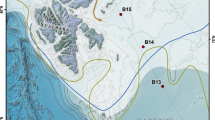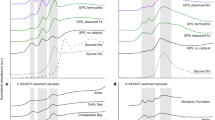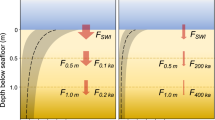Abstract
Fossil carbon, as present in coal, oil and their derivatives, is free from radioactive 14C and its presence in even small concentrations within sedimentary materials can lead to anomalously old radiocarbon ages. For example, Erlenkeuser et al.1 have noted artificially high 14C ages in the upper 20 cm of Baltic Sea sediments in correlation with enhanced heavy metal concentrations. Both findings are consistent with the growth of industrial activity in this location, and the radiocarbon age increase has therefore in the past been regarded as an approximate measure of the extent of pollution of sediment organics by industrial fossil fuels. The results presented here will indicate that the latter interpretation is not always valid and that in studies of coastal marine sediments the incorporation of natural fossil carbon in the samples can introduce considerable error.
This is a preview of subscription content, access via your institution
Access options
Subscribe to this journal
Receive 51 print issues and online access
$199.00 per year
only $3.90 per issue
Buy this article
- Purchase on Springer Link
- Instant access to full article PDF
Prices may be subject to local taxes which are calculated during checkout
Similar content being viewed by others
References
Erlenkeuser, H., Suess, E. & Wilkomm, H. Geochim cosmochim. Acta 38, 823–842 (1974).
Baxter, M. S. & Harkness, D. D. Proc. I.A.E.A. Symp. Isotope Ratios as Pollutant Source and Behaviour Indicators 135–141 (1975).
Swan, D. S. thesis, Univ. Glasgow (1978).
Stenhouse, M. J. & Baxter, M. S. Radiocarbon 18, 161–171 (1976).
Campbell, J. A. & Baxter, M. S. Radiocarbon 21, 171–179 (1979).
Broecker, W. S. & Olson, E. A. Radiocarbon 3, 176–204 (1961).
Natural Environment Research Council, Clyde Study Group, Report, NERC publ. ser. C, No. 11 (1974).
Pennington, W. Fresh water Biol. 3, 363–382 (1973).
O'Sullivan, P. E., Oldfield, F. & Batterbee, R. W. in Quaternary Plant Ecology (eds Birks, H. J. B. & West, R. G.) 267–278 (Blackwell, Oxford, 1973).
Pennington, W. in The Effect of Man on the Landscape: The Highland Zone (res. Rep. Br. Council for Archaeology, 1975).
Dickson, J. H. et al. Nature 274, 548–553 (1978).
Author information
Authors and Affiliations
Rights and permissions
About this article
Cite this article
Baxter, M., Stenhouse, M. & Drndarski, N. Fossil carbon in coastal sediments. Nature 287, 35–36 (1980). https://doi.org/10.1038/287035a0
Received:
Accepted:
Issue Date:
DOI: https://doi.org/10.1038/287035a0
This article is cited by
-
Sediment fluxes and the littoral drift along northeast Andhra Pradesh Coast, India: estimation by remote sensing
Environmental Monitoring and Assessment (2013)
Comments
By submitting a comment you agree to abide by our Terms and Community Guidelines. If you find something abusive or that does not comply with our terms or guidelines please flag it as inappropriate.



